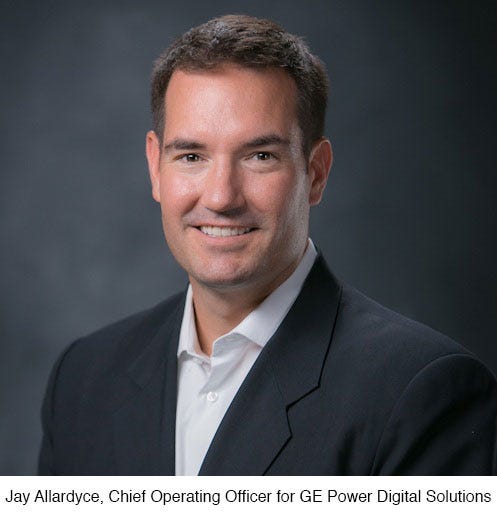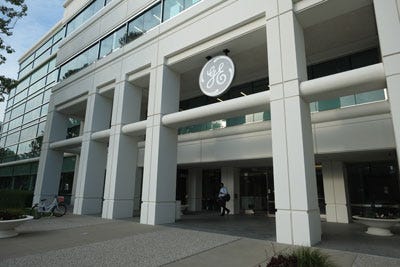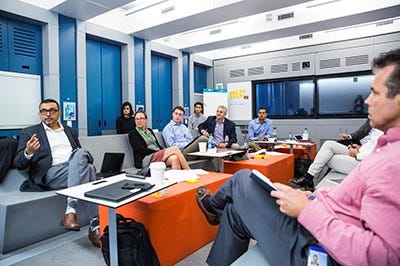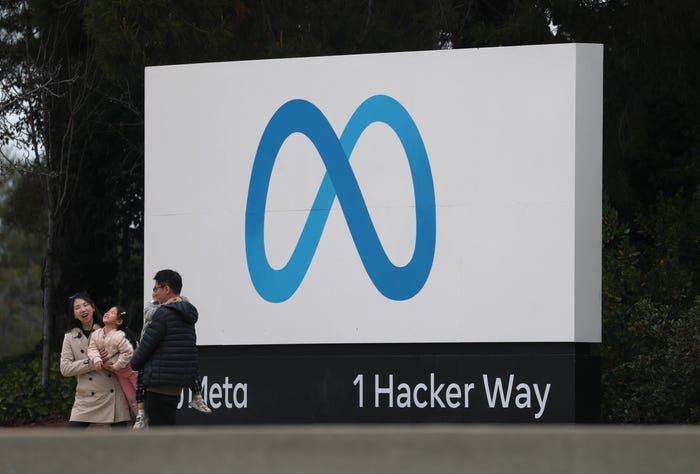Industrial Metamorphosis: What GE Sees Beyond the Looking GlassIndustrial Metamorphosis: What GE Sees Beyond the Looking Glass
The industrial behemoth wants to be cool again by redefining its machine-building legacy.
April 5, 2017

Alice: I simply must get through!
Doorknob: Sorry, you’re much too big. Simply impassible.
Alice: You mean impossible?
Doorknob: No, impassible. Nothing’s impossible.
What do you think of when you think of GE? Light bulbs? Refrigerators? Your mom’s washer and dryer? Or maybe MRI machines, locomotives, and industrial machinery?
For more than a century, GE has been king of the practical. But now, like the main character in Alice’s Adventures in Wonderland, the company is plunging down the rabbit hole without worrying how to get out. It wants to be a leader of what it calls the Industrial Internet. And it wants you to think of the company, which turns 125 this month, as a top-tier software startup. “There is no Plan B. It’s this or bust,” GE’s CEO Jeff Immelt says. And to that end, the company is selling off anything that is inessential. Incidentally, China’s Haier purchased GE’s appliance division last year.
But it also wants to leverage its extensive machine-building knowledge as a competitive advantage. And GE intends to prove that a behemoth industrial company can transform its culture, and sell not just industrial equipment, but business outcomes.
Contemplating GE in 2017 involves pondering an array of seeming contradictions. The industrial giant—the only original member of the 1896 Dow Jones Industrial Average—is betting big on the Industrial Internet while acknowledging that its digital metamorphosis is still in the early stages. GE wants to forge relationships with startups and enterprise companies alike, but retain its independence.
Embracing Systems Thinking
The crux of GE’s reinvention is a shift towards systems thinking—a perspective that many of its customers are also adopting. A utility company, for instance, might have hundreds of power sources supplying its network. To remain competitive, utility executives need to be able to not only monitor the performance of all of their assets, but also keep tabs on how those assets work with each other and correspond with fluctuating energy demand.
GE believes its industrial domain knowledge gives it an edge over pure software firms. “Software companies can’t easily walk onto a plant floor and say: ‘I know how I can help you make your plant more efficient,” says Jay Allardyce, chief operating officer for GE Power Digital Solutions. And there’s the rub — GE aims to use software to do just that.
Industrial companies like GE and Siemens hope that their domain expertise won’t just be good for business in the short term, but will help their business scale in the long run. “It could change what we sell to a customer,” Allardyce explains. “In the future, we may be selling an energy service rather than a gas turbine.”
 “GE has an excellent opportunity to deepen customer relationships and expand its business,” says Chris Kocher, of Grey Heron who advises companies on monetization and product strategies. “By innovating with new business and service models—instead of just technology alone—it can transition to subscription services and recurring revenue models. This approach moves them from a transaction-oriented, one-time, capital equipment sale to a deeper, more enduring customer relationship that yields a recurring revenue stream.”
“GE has an excellent opportunity to deepen customer relationships and expand its business,” says Chris Kocher, of Grey Heron who advises companies on monetization and product strategies. “By innovating with new business and service models—instead of just technology alone—it can transition to subscription services and recurring revenue models. This approach moves them from a transaction-oriented, one-time, capital equipment sale to a deeper, more enduring customer relationship that yields a recurring revenue stream.”
In the end, it goes back to system-level thinking. A digital power plant can take advantage of terabytes of unused data to predict performance anomalies before they happen and perform maintenance when it is needed rather than when it is scheduled. Utilities can determine whether a plant is underperforming or overspending and see how it compares to all of their plants in their portfolio. “What if you had just-in-time insight based on how that plant worked and realized that it wasn’t the part you thought it was, but that it was a surging generator?” Allardyce asks.
A Digital Fate
Ultimately, GE’s software focus may have been unavoidable. In the new millennium, its stock was hit hard by two downturns, falling some 88 percent from its height of $59.88 on September 8, 2000, to its nadir of $7.06 on March 6, 2009. It didn’t help that about half of its business was then tied up in its financial arm. The company’s investment in media also didn’t live up to expectations. Within that same time frame, companies like Apple, Google (now Alphabet), Amazon, and Facebook managed to carve out leading roles in the S&P 500.
Industrial companies are in the information business whether they want to be or not.
Now, the company has reclaimed its industrial heritage. In the 21st century, that means focusing on software. “Industrial companies are in the information business whether they want to be or not,” Jeff Immelt told McKinsey in 2015. “We want to treat analytics like it’s as core to the company over the next 20 years as material science has been over the past 50 years,” Immelt has said. It sees its Predix software platform as the industrial equivalent to Android. But the former is more systems-oriented. While a Predix app could make a single piece of equipment run more efficiently, the real magic lies in optimizing machine networks. For its utility customers, Predix could serve as sort of an energy OS. Think of it as sort of a Waze for machines: that app tracks multiple assets (vehicles) and optimizes instructions for an individual operator (driver) based on what other systems (drivers) are doing.
As Kocher reinforces, “One of the dynamics of IoT systems, or platforms like Predix, is that they increase in value in proportion to the integration across functions or other systems. Hence the need for companies like GE and their customers to promote ‘silo busting.’”
To help with this integration initiative, GE is hiring thousands of software engineers and data scientists. It opened software hubs—what it calls digital foundries—in San Ramon, CA; Paris; and Shanghai. And it launched a multi-million dollar, self-deprecating ad campaign designed to attract software talent. The ad spots follow the plight of Owen and Sarah, young coders who have landed jobs at GE. “I’ll be helping turbines power cities,” Owen says in one commercial. “I put a turbine on a cat,” answers his friend, who works at a fictional app maker Zazzies that puts funny hats on animals. The tagline of the ad campaign is: “The digital company. That’s also an industrial company.”
While GE is especially vocal about its own digital transformation, it is not alone. “We are seeing the top global 1000 enterprises make bigger and bigger bets in digital,” says Mike Quindazzi, managing director at PwC. For many such firms, this means a shift of R&D resources away from physical products to software and services. PwC’s recent Strategy & Global 1000 Innovation survey results showed the average spending for software and services increased from 54% to 59% between 2010 and 2015. It expects that amount to grow to 63% by 2020. “Additionally, leading enterprises are not only viewing software as a catalyst for manufacturing operations, but also smart sensors, collaborative robotics, and 3D printing all connected via IoT,” Quindazzi adds. “Leaders are aiming for productivity gains and to create value from the data with more advanced data analytics leveraging newer machine-learning algorithms.”
Merging Cultures
The biggest challenge for industrial companies aspiring to master software is culture. The core philosophy behind a traditional hardware company and a software firm couldn’t be more different. Many enterprises that have sought to combine the two have struggled to do so. If GE can create a hybrid culture that merges the perspectives of information technology (IT) and operational technology (OT), it would be significant.
“Many companies underestimate the difficulty of integrating the colliding technologies and cultures of OT and IT. GE is firmly planted in both worlds and has an opportunity to show how to do this effectively,” Kocher points out.
GE has worked to pare down its bureaucracy and embrace a Silicon Valley management approach, which it calls “Fast Works.” It seeks to imbue its culture with a commercial intensity that is similar to that of a software startup.
But not all of the business lessons from software startups apply to GE. While some startups work to innovate by breaking rules and questioning assumptions, GE must maintain a conservative approach to quality management. “You could have a machine not working, blowing up, catching fire,” Allardyce says. “You need to be on point.”
Navigating this balance will be like walking a tightrope
“GE needs to maintain a balance between the ‘try stuff and fail fast’ mentality of a startup and the need for process-oriented, industrial quality control,” agrees Kocher. “Too much of the former could damage GE’s brand reputation, and too much of the latter could dampen the start up enthusiasm and retention of young innovative engineers. Navigating this balance will be like walking a tightrope.”
To that end, GE rebuilt a portion of its facility in Atlanta responsible for remote monitoring to better serve its goal to integrate IT and OT. The first floor of that facility is designed to pair up engineers with software developers, bringing together the domain knowledge of the former with the coding savvy of the latter. “That sounds simple and trivial but it has absolutely changed how we work,” Allardyce explains. “I think the biggest part of it is having a mindset of listening a lot more.”
Similarly, the company is moving its headquarters to the urban innovation and startup hub of Boston from suburban Fairfield, CT.
The startup space is just like the restaurant business. There is a high failure rate.
The company is also working to invest in startups and recently announced that it will be investing $2 million in Alchemist Accelerator to help young industrial companies. GE sees mutual benefits when good, innovative technology from startups is paired with an established company.
Allardyce says that its customers want to know that a company will be around long-term before it does business with them. When GE acquired the AI coal-power plant startup NeuCo, several of its customers reached out to express their gratitude. “They said: ‘NeuCo’s technology is great—we know it works—but we didn’t know if they would be around long term,’” Allardyce says. “The startup space is just like the restaurant business,” he adds. “There is a high failure rate.”
Looking Within and Without for Ideas
 GE is expanding its ties to big-league tech companies such as Microsoft, Dell, Accenture, Cisco, Intel, and Verizon while also working to accommodate data from industrial competitors’ equipment. “Many of our customers don’t just have GE equipment,” Allardyce says. “We have to curate the ecosystem.”
GE is expanding its ties to big-league tech companies such as Microsoft, Dell, Accenture, Cisco, Intel, and Verizon while also working to accommodate data from industrial competitors’ equipment. “Many of our customers don’t just have GE equipment,” Allardyce says. “We have to curate the ecosystem.”
The company also wants to partner with its customers to forecast the future of the industrial realm. “Looking at this holistically, you have the domain knowledge of how assets perform and an insane curiosity to wallow in a massive amount of data. You can use this to forecast what the future landscape might hold and say: ‘I am selling nuclear assets one day and buying renewable assets the next. To make that conclusion, you need to have a single view of your portfolio.” Allardyce concludes: “And that is the path we are on. To me, it is cool because it is coming to an industry that is ripe for change.”
We are finding that many of our customers also want to be partners and co-creators.
Breakthroughs come from its employees and its clients. “Somebody might have an idea to write a predictive maintenance algorithm on Predix, and they can publish it and make it available to be monetized as you would think of an app,” Allardyce says. The company has also tested crowdsourcing, researching whether freeing engineers from hierarchy and exposing them to an array of customer conditions could spur innovation. ‘We had more than 200 ideas float up,” Allardyce says. “We also are looking for domain expertise. We are finding that many of our customers also want to be partners and co-creators. They can share what they have built for, say, a smelting plant or petrochemical plant. It kind of comes in all forms.”
GE also hosts hackathons to spur development of new software. One such competition led to the creation of a novel analytic for parts and inventory analysis in 48 hours. The prior version of this code took some 12 months to write.
The company has created an internal analytics catalog where promising software can be shared across the entire organization. Because GE makes an array of “things that spin,” an analytic from, say, its healthcare division might be tailored for use in its energy unit. “There are a lot of behavioral similarities with how well a piece of equipment might work,” Allardyce says. “So it makes sense to leverage code like you would off of a software platform like Github.”
 Kocher highlighted additional opportunities. “GE needs to establish a vibrant ecosystem around Predix that will spur innovation from customers, partners, employees, third-party developers, system integrators, and entrepreneurs.” Ultimately, competitors may feel compelled to be on the Predix platform to reach common customers. “With a large, diverse ecosystem, GE can spur innovation and grow the pie for everyone in a virtuous cycle,” Kocher continues. “In addition, controlling the Petri dish of new ideas will allow GE to pursue a ‘partner-to-purchase’ strategy. That could lead to valuable acquisitions and accelerate GE’s growth and share price.”
Kocher highlighted additional opportunities. “GE needs to establish a vibrant ecosystem around Predix that will spur innovation from customers, partners, employees, third-party developers, system integrators, and entrepreneurs.” Ultimately, competitors may feel compelled to be on the Predix platform to reach common customers. “With a large, diverse ecosystem, GE can spur innovation and grow the pie for everyone in a virtuous cycle,” Kocher continues. “In addition, controlling the Petri dish of new ideas will allow GE to pursue a ‘partner-to-purchase’ strategy. That could lead to valuable acquisitions and accelerate GE’s growth and share price.”
Ultimately, it seems that GE is looking at a parallel world that is connected to our present reality—similar to how Lewis Carroll’s Alice peered through the looking glass to behold a world of wonder that has a logic all its own. It’s fitting that Carroll, a master of fantasy, was also a mathematician. And GE’s marketing of its digital prowess seems at once preternatural and practical. On the one hand, it’s a conversation starter for its customers and an invitation for them to help create a magical-seeming future. On the other, it helps attract younger coders to eschew the illogically fantastical to come work for an industrial company. To paraphrase the aforementioned GE ad: Would you rather transform the way the world works? Or put a casaba melon helmet on a cat?
About the Author
You May Also Like




